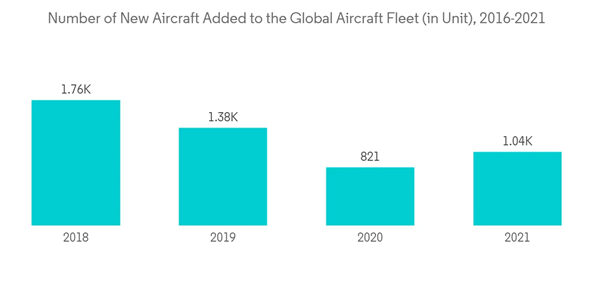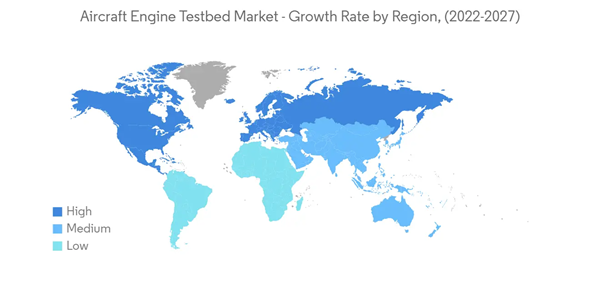The aircraft engine testbed market is projected to grow with a CAGR of over 1.50% during the forecast period.
The global aircraft engine testbed market witnessed reduced growth due to the COVID-19 pandemic. The aviation sector saw unprecedented challenges amid the pandemic. Travel restrictions reduced air travelers, and decreased aircraft orders have severely impacted the aviation industry. However, with the market showcasing a strong recovery post-COVID with an increased number of air passengers and the projected increase in passengers to pre-pandemic levels, the aircraft engine testbed market is expected to witness a significant growth rate during the pandemic.
Demand for new aircraft increased due to rising air traffic, modernization of aging aircraft, and growing investment in aircraft maintenance, repair, and overhaul, driving the market growth. Aircraft engine testbeds test engine performance and collect necessary data from the tests. Testbeds and testing engines in the sky Engines need to be certified as safe and fit. The primary engine manufacturers used flying testbeds (FTBs) to check engine performance. These FTBs can validate engine performance at 40,000 to 50,000 feet above the ground, which helps in improving safety.
In addition, the rapid expansion of the aviation sector, growing air traffic, and rising aircraft orders create demand for aircraft engine testbeds. Furthermore, various governing bodies tighten the safety norms due to increased accidents and mishaps occurring around aircraft, which drives the market growth.
For instance, in February 2022, Airbus entered into a partnership with CFM International (a joint company of GE and Safran Aircraft Engines) to develop an A380 flying testbed called the ZEROe Demonstrator to examine how hydrogen combustion can be used to power turbofan jet engines. Furthermore, rising procurement of military aircraft will create demand for engine testbeds, driving the market growth. In July 2022, the United States Department of Defense (DoD) signed a three-year contract with Lockheed Martin Corporation to manufacture 375 F-35 fighter jets.
Furthermore, according to the International Air Transport Association (IATA) report, India will surpass the United Kingdom and become the third-largest aviation market by 2024. Increasing expenditure on the aviation industry and developing new airports lead to increased demand for new aircraft. Furthermore, in 2020, the Indian government plans to build 100 new airports to improve regional connectivity by 2024.
Additionally, the Indian government has a strong focus on strengthening military capabilities. China and India were the second and third largest defense spenders, respectively in 2021. Thus, growing spending on military aircraft procurement from India and China drives the market's growth across the region.
This product will be delivered within 2 business days.
The global aircraft engine testbed market witnessed reduced growth due to the COVID-19 pandemic. The aviation sector saw unprecedented challenges amid the pandemic. Travel restrictions reduced air travelers, and decreased aircraft orders have severely impacted the aviation industry. However, with the market showcasing a strong recovery post-COVID with an increased number of air passengers and the projected increase in passengers to pre-pandemic levels, the aircraft engine testbed market is expected to witness a significant growth rate during the pandemic.
Demand for new aircraft increased due to rising air traffic, modernization of aging aircraft, and growing investment in aircraft maintenance, repair, and overhaul, driving the market growth. Aircraft engine testbeds test engine performance and collect necessary data from the tests. Testbeds and testing engines in the sky Engines need to be certified as safe and fit. The primary engine manufacturers used flying testbeds (FTBs) to check engine performance. These FTBs can validate engine performance at 40,000 to 50,000 feet above the ground, which helps in improving safety.
In addition, the rapid expansion of the aviation sector, growing air traffic, and rising aircraft orders create demand for aircraft engine testbeds. Furthermore, various governing bodies tighten the safety norms due to increased accidents and mishaps occurring around aircraft, which drives the market growth.
Aircraft Engine Testbed Market Trends
Fixed-Wing Segment is Anticipated to Hold Largest Market Share During the Forecast Period
The fixed-wing segment will showcase significant growth during the forecast period. The increase is attributed to rising air travelers, growing investment in constructing new airports, and MRO services. Furthermore, increasing deliveries of business jets, fighter jets, and general aviation aircraft will drive the market's growth. For instance, GTRE and Safran will jointly develop a 110kN powerplant for India’s 5th generation AMCA program. Safran has proposed to use Dassault-owned Rafale as a flying test bed. Thus, rising investment in developing flying testbeds and the upgradation of aging aircraft fleets will drive the market's growth.For instance, in February 2022, Airbus entered into a partnership with CFM International (a joint company of GE and Safran Aircraft Engines) to develop an A380 flying testbed called the ZEROe Demonstrator to examine how hydrogen combustion can be used to power turbofan jet engines. Furthermore, rising procurement of military aircraft will create demand for engine testbeds, driving the market growth. In July 2022, the United States Department of Defense (DoD) signed a three-year contract with Lockheed Martin Corporation to manufacture 375 F-35 fighter jets.
Asia Pacific may Showcase Highest Growth During the Forecast Period
Asia-Pacific is anticipated to grow with the highest CAGR during the forecast period. Rapid urbanization, growing air traffic, and rising demand for new aircraft drive regional market growth. An increase in air travelers and growing expenditure on the aviation sector from emerging economies such as China and India boost market growth. COMAC, a Chinese aircraft manufacturer, forecasts China will become the world’s largest aviation market by 2040. Furthermore, the country’s aircraft fleet will reach 9,957 by 2040, accounting for 22 percent of the global passenger aircraft fleet.Furthermore, according to the International Air Transport Association (IATA) report, India will surpass the United Kingdom and become the third-largest aviation market by 2024. Increasing expenditure on the aviation industry and developing new airports lead to increased demand for new aircraft. Furthermore, in 2020, the Indian government plans to build 100 new airports to improve regional connectivity by 2024.
Additionally, the Indian government has a strong focus on strengthening military capabilities. China and India were the second and third largest defense spenders, respectively in 2021. Thus, growing spending on military aircraft procurement from India and China drives the market's growth across the region.
Aircraft Engine Testbed Market Competitor Analysis
The aircraft engine testbed market is consolidated and characterized by a few players who provide engine testbed facilities. Some prominent aircraft survival equipment market players are Safran SA, Rolls-Royce PLC, Raytheon Technologies Corporation, CFM International, Froude, Inc., Nidec Industrial Solutions, Honeywell International Inc., and others. Technological advancements and the introduction of new technologies in engine testbeds will likely drive market growth.Additional benefits of purchasing the report:
- The market estimate (ME) sheet in Excel format
- 3 months of analyst support
This product will be delivered within 2 business days.
Table of Contents
1 INTRODUCTION
4 MARKET DYNAMICS
5 MARKET SEGMENTATION
6 COMPETITIVE LANDSCAPE
Companies Mentioned (Partial List)
A selection of companies mentioned in this report includes, but is not limited to:
- Safran SA
- Raytheon Technologies Corporation
- Honeywell International Inc.
- Rolls-Royce PLC
- CFM International
- Froude Inc.
- Nidec Industrial Solutions
- General Electric
- HAECO
Methodology

LOADING...










